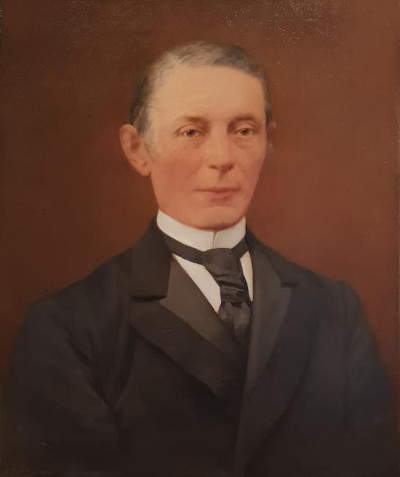Here we discover a pendant with portraits on both sides. The painting captured here was a picture of S.J.C. van Aalst, with H.H. van Aalst-Haagedoorn on the other. The overall piece is dated at around 1910, by which time the artist's career was just starting to take off.
Whilst using initials for the title of the piece, the full name of the model here was actually Salomon Cornelis Johannes van Aalst. The figure stands in front of us within a portrait which is cut off from the waist. He wears a smart black suit with black tie and white shirt. Van Aalst's hair is equally well presented, slick down as was the common style for this period. The expression is formal and serious, looking directly at the artist in a manner which had been seen within the art world for centuries. It is therefore classical style portrait in many ways, with perhaps Mondrian seeking to simply earn a living at this point rather than being able to express himself in a more contemporary manner, which he no doubt would have preferred to do. Behind the model is a bright brown wall which offers an alternative tone but without any detail that might distract us from the main focal point. Artists have for many years been caught between the work that they want to produce, and that which helps them to pay their bills and Mondrian was no different in that regard.
This painting would be handed down through the family of the model but did come up for sale in Amsterdam in 1988. The two sided piece captures a married couple and no doubt their family would have been the patrons for this artwork. According to the records that we have available, neither individual would actually have been alive at the time of these portraits being completed, and so they must have been requested by younger generations within the family as a means to remembering them both. It is therefore unsurprising that the artist delivers both portraits within a complementary manner and gives the impression of a couple who were highly respected individuals and perhaps an important part of the local community. The artist would take on these types of commissions more so in the early part of his career when funds were tighter and he could be less fussy about the type of work that he produced.
Items such as this as really important in reminding us of the breadth of skills which Mondrian possessed. He was not someone who merely switched to abstract art because he could not work effectively in any other manner, which is an accusation that some give to contemporary artists. Instead, he simply wanted to be innovative and working in ways that had been done for centuries simply did not appeal to him, even though it would have made it easier for him to earn a living. He may still have got some joy from portraits such as this, though, and was also keen to improve his technical work with portraiture because it was a key element to achieving academic respect in the Netherlands at that time.




